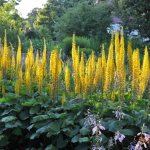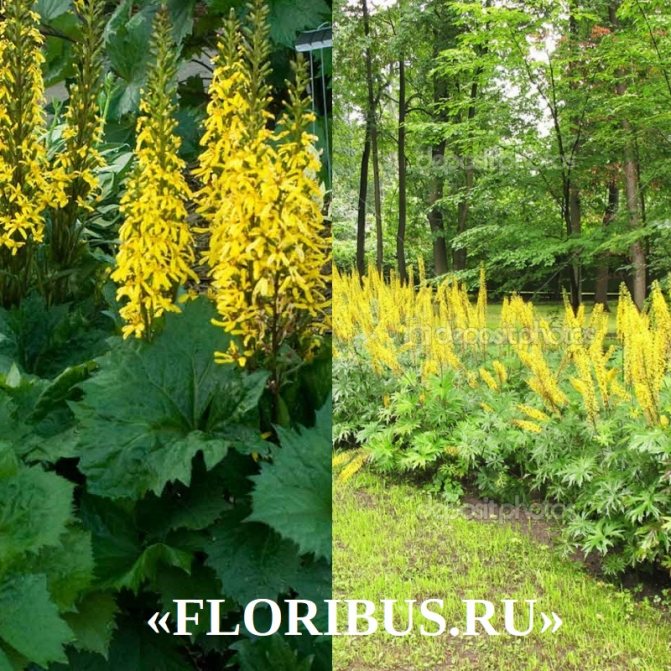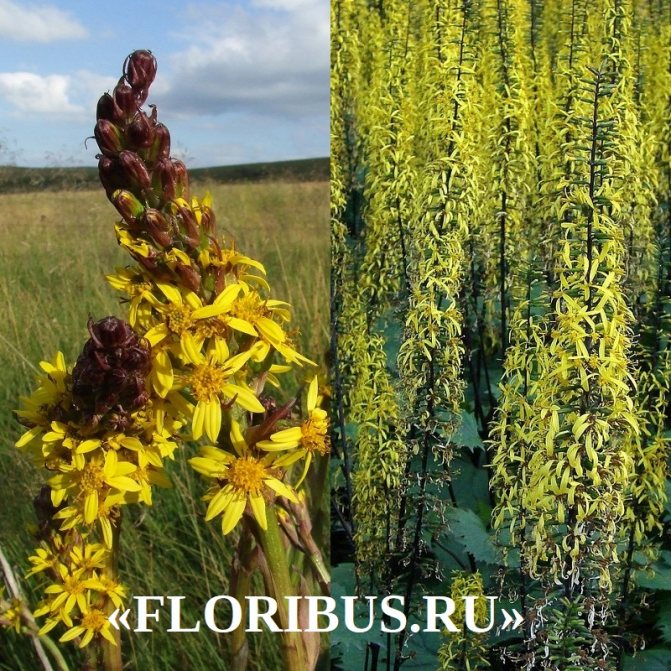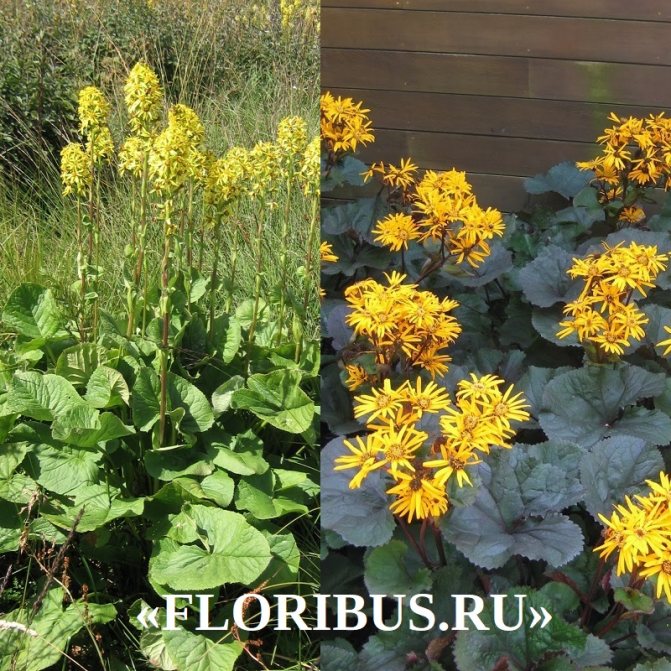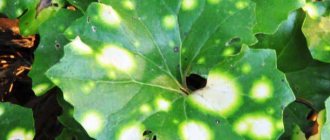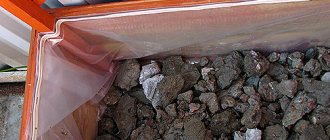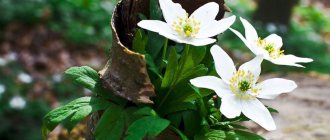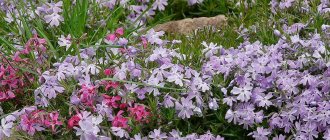The color of the leaf can be from rich green to dark green. There are also purple and dark brown leaf colors.
Description Buzulnik Przewalski
Buzulnik is a perennial herb, belongs to the Astrov family. Due to the shape of the marginal flowers, it has a second name for ligularia. There are many varieties of this plant.

Buzulnik Przhevalsky is named after the Russian traveler
Buzulnik Przewalski (ligularia przewalskii) got its name in honor of the Russian naturalist and traveler Nikolai Przewalski. In addition to Central Russia, the flower can often be found in the Urals, but the plant is most common in some regions of China. In this country, it is used as a medicine - antibacterial substances are present in its root system.
The flower is tall and can reach a height of 1.8 meters. The leaves are dissected, very delicate with sharp edges, located on petioles of a red-brown hue. Buzulnik Przewalski differs in inflorescences - they are collected in spikelets and can reach 70 cm in height, while their tops may be slightly sagging.
The variety belongs to the early ones. The flowering period begins at the end of June, ends in about a month - at the end of July, after which seed formation occurs.
Attention! The plant loves shaded and wet areas, grows well near water bodies.
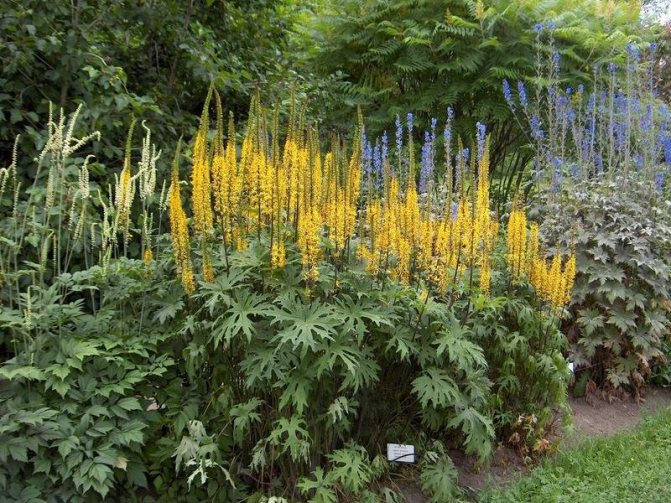

The culture grows quite high, it is decorative
Garden species and varieties of buzulnik (with photo)
Among the large number of species in the genus Buzulnik, only a few can be used as garden specimens, since not many have the desired picturesqueness. A large number of variants are considered weeds by botanists, or they grow in conditions that are difficult to recreate artificially in our country.
Of the popular decorative forms, the most common one can be distinguished - the toothed buzulnik, which more often than others becomes a decoration of gardens. Representatives of this species grow up to 1 meter, the shoots of plants are very strong and do not require additional garter to support. On the stems are kidney-shaped leaves collected in a basal rosette. During the flowering of the toothed buzulnik varieties, we will see basket inflorescences, up to 8 cm in diameter. More often there are buds with yellow petals and brown tubular flowers. Active flowering is observed from the beginning of August and lasts no more than 2-3 months.
Of the most popular varieties of toothed buzulnik, breeders distinguish:
- "Othello" is an ornamental plant with picturesque large leaf plates, up to 50-60 cm long in diameter.The lower part of the leaf is burgundy, the upper one is bright green. The inflorescences of a tangerine shade are impressive in size - up to 13-15 cm in diameter.
- “Desdemona” is a lilac leaf with a strongly serrated edge with a brown tint. Numerous inflorescences of shades of yellow, collected in tall ears.
- "Osiris Fantasy" is a small dwarf plant no more than 40-50 cm high. The plant acquires a special decorative effect due to the leaves - the back part is burgundy, the frontal part is dark green. The variety is considered early, since the inflorescences begin to bloom in early July.
- "Brit-Mary Crawford" - a plant up to 120 cm high, blooms from late June to early autumn. The front part of the leaf plates is brown, the inside is purple. Inflorescence baskets are orange or bright yellow.
- "Dark beauty" is a dark beauty of all kinds. Especially decorative variety for lovers of exotic solutions. The leaf plates are very large, collected in root rosettes, creating a "pillow" of a rich purple hue. Above them, on long peduncles, yellow baskets are located.
Another popular species, Przewalski's buzulnik, has become widespread as an unpretentious plant. High growth and rapid development allow you to create large hedges on the site or use varieties as a backstage. Flowering begins at the end of July and lasts until the first frost.
Siberian Buzulnik is a species that includes a large number of varieties from dwarfs to large herbaceous bushes. Elongated, heart-shaped leaves are collected in powerful root rosettes. The baskets of the Siberian species are yellow, collected in a brush.
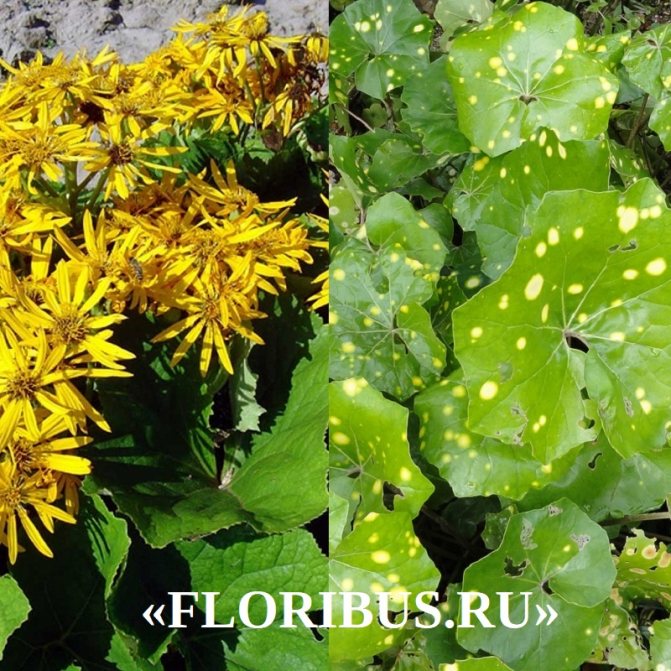

The narrow-leaved appearance is very similar to the Przhevalsky buzulnik, thanks to which every year breeders breed a large number of interesting species. Serrated leaves are slightly narrower than other species. The variety "Rocket" is of great decorative value; it is represented by plants up to 2 meters high with small yellow baskets of inflorescences, collected in panicles or brushes. Some gardeners prefer to grow on their plots a smaller form called "Little Rocket". Both varieties are very decorative and bloom from early July to late summer, see them in the photo below:
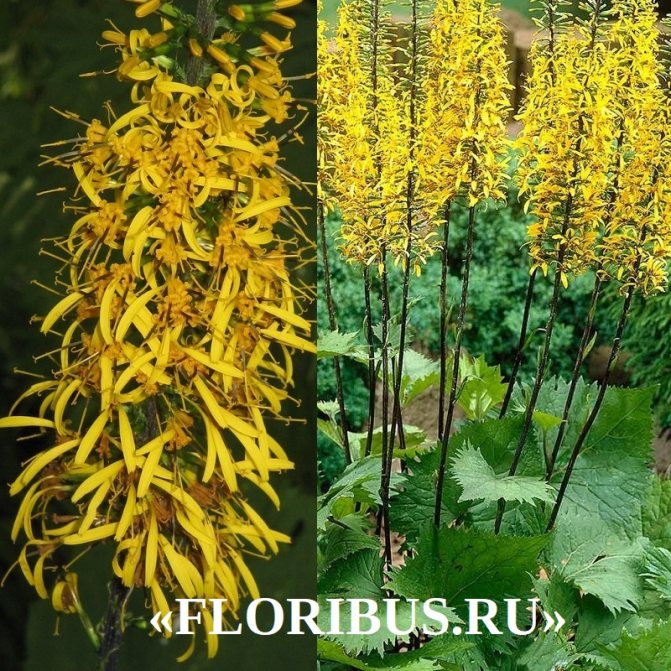

Planting a plant
The plant is planted with seeds. However, it is worth remembering that a culture grown in this way will bloom only after 3-4 years. The method itself is quite laborious, it takes time and care.
Planting from seeds
Hydrangea Vanilla Fraz - planting and care in the open field
First of all, prepare the soil in a separate place. In autumn - November, December - seeds are sown into the ground to a depth of about 2 centimeters. In this case, they will undergo natural stratification.
In the spring, when the snow melts, seedlings will begin to appear. When they get a little stronger, you can transplant them to a permanent place.
Planting seedlings in open ground
Buzulnik can also be planted using seedlings. At home, seeds begin to sow in March. Fertile soil is poured into the container, the seeds are laid out to a depth of no more than 1 centimeter. The pot is covered with foil or glass.
Maintain soil moisture and moderate temperatures at all times. When shoots appear, the shelter is removed and they continue to look after them. Gradually, the sprouts will grow up and they can be transplanted into separate pots.
Attention! Seedlings should be planted outside after the threat of repeated frosts has passed.


Inflorescences are spikelets
How to care for a Przewalski buzulnik
Buzulnik Przewalski is an unpretentious plant that even a beginner can handle. However, some care features are still required to be observed.
Watering
Spirea - planting and care in the open field
The plant loves moist and nutritious soil.It will grow well next to water bodies and in the shade of large trees. In this case, irrigation will only be needed in very dry times. If the flower grows in drier soil, then watering should be carried out regularly. To maintain the necessary moisture, it is allowed to use mulch in the form of shavings or straw.
Continuous irrigation is carried out until the onset of autumn days, after which the frequency is halved to avoid decay of the root system. In addition, this type of buzulnik also does not like to be in constant moisture, therefore it is not recommended to be too zealous.
On dry days, spraying the plant with warm water is allowed. The procedure is carried out in the morning or in the evening to prevent direct sunlight from reaching the foliage and to avoid burns.
Attention! The Przewalski variety does not like to be in the sun, so open areas will not work for him - the plant will wither and may die.
Top dressing
Buzulnik Przewalski, like any other cultivated plant, perfectly accepts various dressings. They can be organic and mineral. The first time fertilization is applied during planting, it is recommended to use mineral fertilizers that are most suitable for this type of soil. Humus is added every year.
In the spring (in May), the culture is fertilized with a solution of cow dung. Mix with water in a ratio of 1/10. One bush will require up to 4 liters of ready-made solution, watered at the root.


Buzulnik Przewalski will add decorativeness to any area
Pruning
Buzulnik Przewalski does not require pruning. Remove old and dried leaf blades, branches. If reproduction is not planned using self-seeding, then immediately after flowering, it is required to cut off the inflorescences. In this case, the appearance of seeds will not occur. In addition, nutrients begin to be distributed to the leaves and shoots, and not only go to the inflorescences.
Pruning is also carried out before preparing for the winter period. The branches are cut very low, then they sprinkle the bush with leaves, mulch with humus. If you wish, you can cover the plant with special material, although the culture survives winter frosts quite normally.
For reference! Planting and caring for Przewalski's buzulnik does not require much effort and time. Even an inexperienced person can cope with such a culture.
Preparation stages before planting a buzulnik
Buzulnik is a rather unpretentious plant, however, for its full growth and flowering, you need to carefully prepare. First of all, the final result will depend on the planting material that you purchase. Further, it is important to pay attention to the choice of a planting site, although this plant can take root almost everywhere. It is important to prepare the soil well.
Stage 1. Selection of seedlings
If you do not have a buzulnik on the site, and you really want to try to grow this unusual plant, then you need to buy a buzulnik only in specialized nurseries and stores. This is the only way you can be sure of the purchased planting material. On site in the nursery, you can be told when the seedling was planted, what conditions it prefers.
Under no circumstances should you buy Buzulnik saplings in spontaneous markets or along roads. In such a case, there is a risk of acquiring poor quality planting material.
When buying, it is important to pay attention to the appearance of the seedling. A young plant should not have any damage or signs of disease: dry and broken roots and stems. When choosing seedlings, you also need to take into account the planned planting site, since different varieties of buzulnik have different peduncle heights and color of flowers.
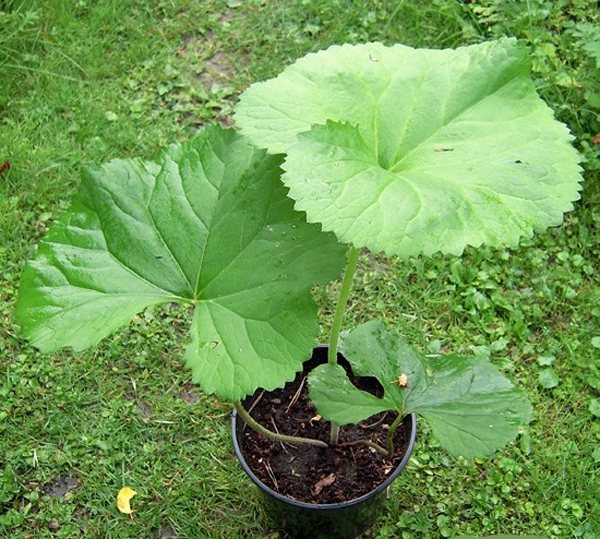

Stage 2. Choosing a landing site
All types of buzulnik prefer to grow on fertile and moist soils. Shade or partial shade is ideal for them.When planting this plant in a sunny area, you risk losing all its decorative features. But subject to constant and abundant watering, this is still possible.
Perfect for planting places under old fruit trees, along fences or various buildings, as well as near natural or artificial ponds and reservoirs.
Stage 3. Preparing the soil
Buzulnik can be planted in open ground in autumn or as seedlings in spring. Depending on the planting time, you need to prepare the garden bed before the planting process itself. It is important to dig well the place that you have chosen for planting. Buzulnik loves fertile and loose soil, so it is recommended to dig up on a shovel bayonet. Fertilizers are applied at the time of planting or transplanting a plant.
Reproduction methods
Hydrangea Dubolistnaya - winter-hardy varieties, planting and care
Reproduction of Przewalski's buzulnik is carried out in two ways - by seeds and by dividing the bush.
In order to get seeds, at the end of flowering, fabric bags are left on good inflorescences, tightly tying them. After a while, they are cut from the branches, the seeds are exfoliated and dried well.
In the fall, the seeds are poured into the ground, where they are located throughout the winter, and in the spring they begin to germinate. Then everything is done in the way described above.
Dividing the bush allows you to immediately get a large plant, which, moreover, will begin to bloom earlier than those that grew from seeds.
- The rhizome is cleaned of the earth, washed.
- They are carefully divided into several parts, provided that each of them has an active kidney.
- Sections must be disinfected or sprinkled with charcoal.
- Before planting, it is required to prepare holes 40 * 40 in size, in which humus and fertile soil are poured on the bottom.
- New shoots are neatly placed in them, filled up with soil and watered well.
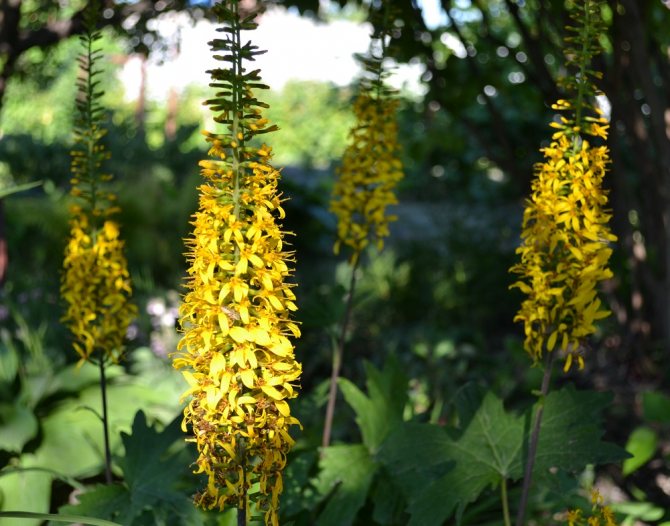

After flowering, seeds appear instead of flowers
A bit of botany
One of the most common ligularia in our gardens is Przewalski's buzulnik, planting and caring for which are available even to those gardeners who are just starting to practice floriculture. It is a tall perennial that grows up to 1.5 meters, the splendor and decorative effect of which is given by large maple-shaped and heavily excised leaves, sitting on brownish-red cuttings that stand out against a green background. The blooming Przewalski's buzulnik is especially beautiful, a photo of which you can see below.
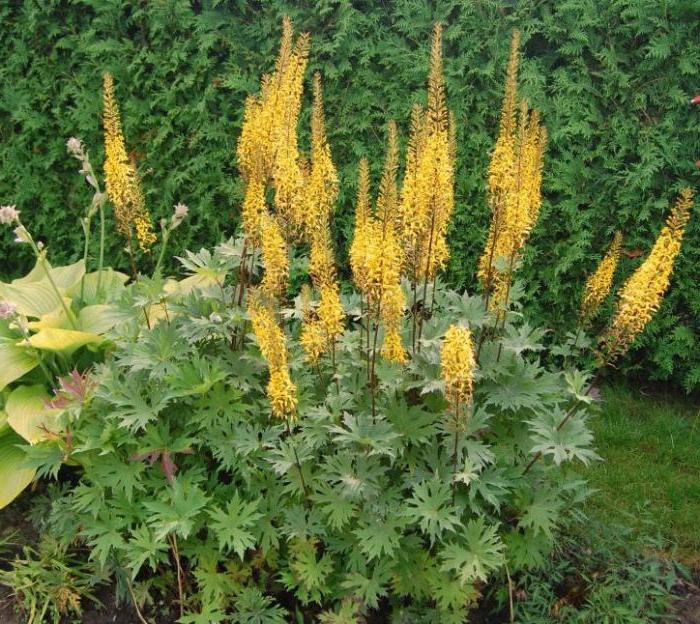

Transfer
Buzulnik Przewalski is a perennial plant. In one place, he can be up to 20 years. However, experienced gardeners recommend rejuvenating it by dividing every 5 years.
If necessary, the bush can be transplanted to another place. To do this, first prepare a pit suitable for the root system. Fertile soil and humus are poured into it.
The flower itself is carefully transferred to a new place with a lump of earth. The required amount of soil is poured, it is slightly compacted. The plant is well watered.
For reference! It is best to carry out such actions in spring or early autumn, so that the culture has time to adapt to new conditions before winter.
Diseases and pests
Przewalski's buzulniks are practically not exposed to diseases and are not affected by pests. The most common disease is powdery mildew, which can develop due to high humidity. If signs are found, it is recommended to use fungicidal preparations and treat the entire plant. In addition, it is imperative to normalize watering.
Due to constant humidity, slugs may appear on the site, which also damage the flower. They eat leaves and branches, after which the plant loses its decorative appearance and may even die. You can deal with the problem both by folk and chemical methods, using specialized drugs.
Snails do the same harm as slugs. The methods of dealing with them are similar.
Flowering period
Buzulniki Przewalski bloom in June-July. Inflorescences are, most often, spikelets of small flowers. However, for example, in the cultivar Buzulnik Palmatiloba, the spikelets of inflorescences are quite large and noticeable.
Shoots with wilted panicles are removed if they do not want seeds to form. During the flowering period, a pleasant aroma appears, which can be carried several meters from the flower bed.
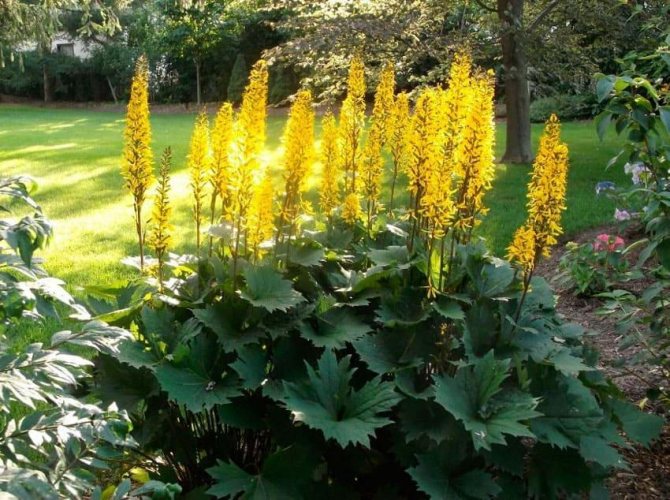

The plant is very fond of landscape designers for its decorative appearance and unpretentiousness.
Use in landscape design
Buzulnik Przewalski is often used for landscape design. The bushes of the plant are quite powerful, the leaves are delicate, the flowers are bright and attract attention. Plants are usually used to decorate ponds, recreation areas. The culture is well suited for flower beds and flower beds.
The flower grows well alone, but in the company of other plants it also has a decorative look, for which it is loved by many designers. It goes well with plants with blue flowers. In addition, the buzulnik is completely unpretentious and is a perennial, therefore it allows you to create designs that retain their attractiveness for a long time.
Buzulnik Przewalski is one of the many varieties of this plant. Perfect for areas with moist soil, grows well in the shade, does not like constant sun. The culture does not require special care, rarely gets sick and is practically not damaged by pests, so even a novice florist can grow it.
Care
Buzulnik includes powerful foliage with a huge number of inflorescences. For this reason, it requires regular watering.
In addition, you should pay attention to the recommendations for planting it - the best site is considered near the reservoir, and it does not matter whether it is artificial or not.
In the summer heat, the plant requires daily watering and irrigation.
Of the key points when leaving, it is worth noting the recommendations of flower growers in pruning this perennial, which has the form of trimming the arrows of flower bearers before the beginning of the winter period. This procedure will make it much easier for the plant to endure severe frosts.


Despite its excellent stability, it still needs to be tied up so that strong gusts of wind do not break it.

